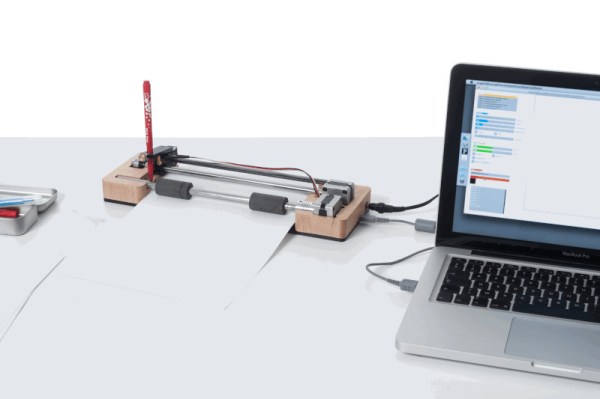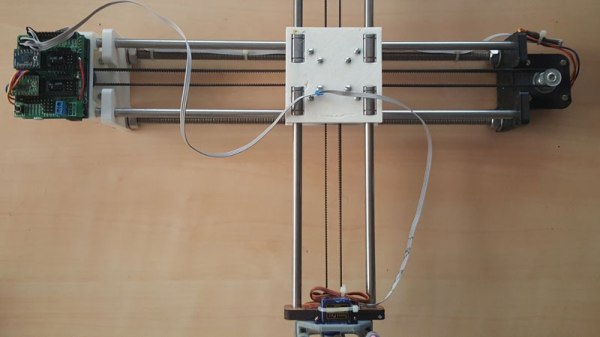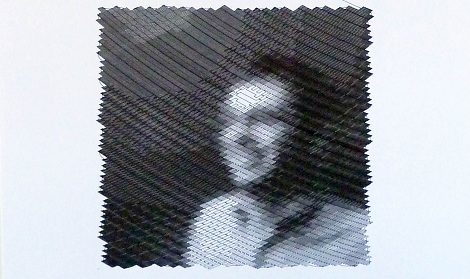Like many of us, [Benjamin Poilve] was fascinated when he took apart a broken printer. He kept the parts, but unlike most of us, he did something with them, building a neat little plotter called the Liplo. Most pen plotters work by moving the pen on two axes, but [Benjamin] took a different approach, using the friction drive bars from the printer to move the paper on one axis, and a servo to move the pen on the other. He’s refined the design from its initial rough state to create a very refined final product that uses a combination of salvaged, 3D-printed, and CNC-milled parts.
Home Made Pen Plotter
As someone who started using computers in the last century, I find the current resurgence of pen plotters somewhat nostalgic. The difference, of course, is that this century it is easier to make your own, which is what [Miguel Sanchez] is doing.
Inspired by the Axidraw, he is making his own pen plotter. He’s made great progress so far, creating a design that looks quite simple to build. His design is driven by an Arduino Uno with a stepper shield, a couple of NEMA 17 stepper motors and a servo to raise and lower the pen. Throw in a few rods, a belt or two and a number of 3D printed parts, and you’ve got a decent looking pen plotter.
He originally started with laser cut components, but shifted over to 3D printing as the design evolved. It’s not as fancy as the HP pen plotter I used to print out rude words in giant letters with in my youth (a HP7475, I think), but it is a neat build. Check it in action in the video below.
Simple DIY Pen Plotter, Great First CNC Project
[Morten] has been busy recently making a pen plotter. It is a simple and elegant build that he completely designed from the ground up. There are no extra frivolous parts here. The frame is made from laser-cut plexiglass which makes fabrication easy if you have access to a laser cutter. Two NEMA17 motors are responsible for the machine’s movement. One moves the pen carriage back and forth by way of a belt. The other is connected by laser-cut gears to a roller bar, scavenged from an ink jet printer, that moves the paper media forward and aft underneath the pen.
The software chain used here is sort of uncommon compared to other inexpensive DIY CNC machines we see here on Hackaday. [Morten] creates his geometry with Rhino, then uses a plugin called Grasshopper to generate the g-code that controls the machine. That g-code is sent using gRemote to an Arduino flashed with the contraptor.org g-code interpreter. A RAMPS board takes the step and direction signals generated by the Arduino and moves the two stepper motors appropriately.
In typical open-supporting fashion, [Morten] has made his design files freely available for anyone to download. His plotter moves the pen side to side and the paper front to back in order to draw shapes but that’s not the only way a plotter can work. Check out this polar plotter and this one that hangs.
Check out the video after the break…
Continue reading “Simple DIY Pen Plotter, Great First CNC Project”
Android Pen Plotter Snaps, Processes, And Prints Pictures

Here’s an Android powered pen plotter that does it all. It was built by [Ytai Ben-Tsvi] to take with him to Maker Faire. He’s the creator of IOIO, a hardware interface module designed to communicate with an Android device via USB (host or OTG are both supported).
The physical hardware is simple enough. He draws on a pad of white paper using a felt-tipped marker. Located at the top of the easel are two wheels with stars etched on them. They are reels which spool and dole-out string to control the pen’s movements. The pen tip can be lifted by a ball bearing mounted just below it.
But the project really takes off when you watch [Ytai’s] demonstration. The Android tablet controlling the device captures a picture of an object — in this case it’s a toy truck. The app then processes it using edge detection to establish how to plot the image.
Continue reading “Android Pen Plotter Snaps, Processes, And Prints Pictures”
Center Pivot Pen Plotter
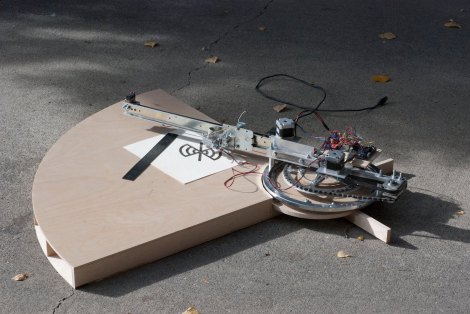
This center pivot pen plotter is an interesting take on the idea, and manages to somewhat simplify the fabrication when compared to a gantry-style built.
Normally we’d see a gantry that travels on two rails, with a print head that moves along its length. Here the gantry is anchored on just one side, with a chain driven system to rotate it along the plotting surface. The print head uses a fine-point felt-tipped marker. It still travels along the arm as you would expect, and can be tilted away from the paper for repositioning.
What was made easier in hardware ends up adding to software complexity. The benefit of a traditional system is that it uses X and Y coordinates to plot a design. The pivot of this mechanism means that as the print head moves further from the center of the machine, the distance between each pixel is magnified. But the clip after the break proves that this issue has been solved.
Polar Pen Plotter Draws Huge Images Very Slowly
[Euphy] just posted an Instructable of his Polargraph drawing machine that’s able to draw huge images slower than molasses in November. The plotter only uses two stepper motors to control the position of the pen and can be made nearly entirely from salvaged parts – [Euphy] built his for just about £150.
The Polargraph uses two stepper motor on the top corners of a large, flat surface. A weighted pen carriage is attached to both motors with beaded cord that’s often seen in window blinds. By controlling the distance from the carriage to each motor, the position of the pen can be precisely controlled. It’s not a very fast way of drawing an image (check out the real-time video), but it sure is interesting to watch.
There have been a few other rope-and-chain plotters, like Der Kritzler and Hektor. [Euphy]’s work is the is one of the best documented builds we’ve seen, and he’s also put up the code and a website.
We really could have used [Euphy]’s plotter when we wanted to draw some whiteboard art. While we’re out dumpster diving for some small stepper motors, check out the time-lapse video of the Polargraph after the break.
Continue reading “Polar Pen Plotter Draws Huge Images Very Slowly”
Insanely Kludgy Pen Plotter Actually Works
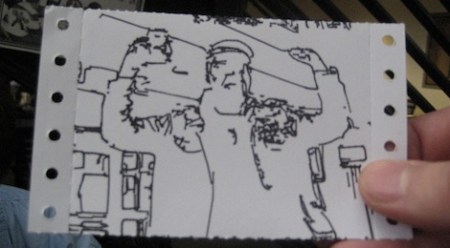
This pen plotter, held together with structural epoxy, is an amazing piece of engineering, and almost as impressive as a bridge made entirely out of Bondo.
[Brian] at the Rochester, NY hackerspace Interlock needed to build something for the BarCamp geek “unconference.” To lure BarCamp attendees over to the Interlock table, they needed a small tabletop device with whirring motors that was able to make some decent swag. Hacking together a pen plotter sounded like the perfect project.
The mechanics of the build were scavenged from old printers and scanners. [Brian] decided to use pin-feed card stock, so the take-up wheels from an old dot matrix printer was sacrificed as well. This paper feed mechanism serves as the Y axis, and the X axis rides above the paper on precision rods. The pen holder is supported by a tiny solenoid.
Things start getting crazy at the software level. grbl was loaded onto an Arduino with a stepper driver shield, and vector text drawings were printed. After a bit of live-action hackery, [Brian] figured out how to plot captured webcam images. OpenCV captures and does a trace outline. This is converted to vectors with autotrace, and from EPS to HPGL by pstoedit. A Python script then cleans up the HPGL and converts it to G code and sends it to the printer. Confused? So are we, so just check out the video of the plotter in action after the break.
Continue reading “Insanely Kludgy Pen Plotter Actually Works”

